Get the weekly SPARTANAT newsletter.
Your bonus: the free E-Book from SPARTANAT.
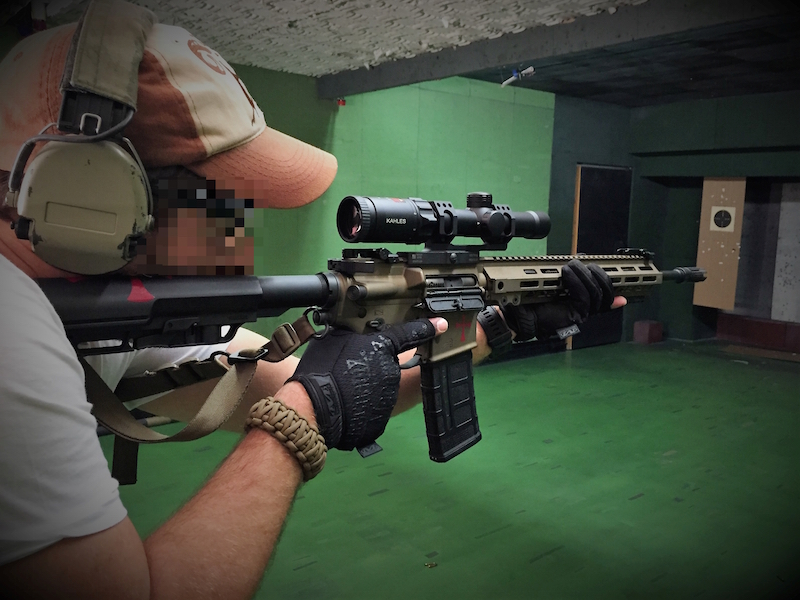
REVIEW: Kahles K15i 1-5x24 rifle scope
The text discusses the Kahles K15i 1-5x24 scope, highlighting its exceptional features such as wide field of view, illuminated reticle, and high eye relief. The scope is described as a top-quality product for semi-automatic rifles, with minimal weaknesses compared to red dot sights. Despite a higher price, the Kahles K15i is recommended for its superior performance and design. The detailed review provides a comprehensive overview of the scope's specifications and performance in various shooting scenarios.
Dynamic scopes in the area of simple magnification 8x usually all have one problem: they are a compromise. You don't have a real red dot sight, you don't have a long range with the glass, let alone enough light because of the usually small objective. The shortcomings are generally known and often discussed in various forums - what is better, what is the ideal setup for IPSC, short-to-midrange, and so on. The dedicated red dot sight shooters also show up sooner or later and put an end to the discussions, with a statement that applies to many glasses in the low-magnification category: Too heavy, inadequately illuminated, and above all much too small eye box. The company Kahles from Austria shows that it can be done differently and has provided us with a Kahles K15i 1-5×24 scope for testing. Here is the report.
As we usually shoot handy semi-automatic rifles, glasses with low to medium magnification are exactly in our core area of interest. It's no wonder that we have already gathered some experience in this segment and looked through numerous scopes. Whether it was devices in the lower price range like the Vortex Strike Eagle or the Optisan CX6 that we tested (HERE the review), Burris, Bushnell, and others from the mid-range, and for example Schmidt & Bender from the high-end - all these scopes have a great picture as long as you haven't looked through a Kahles K15i yet.
But one pretty thing at a time - let's start with the core data of the glass. 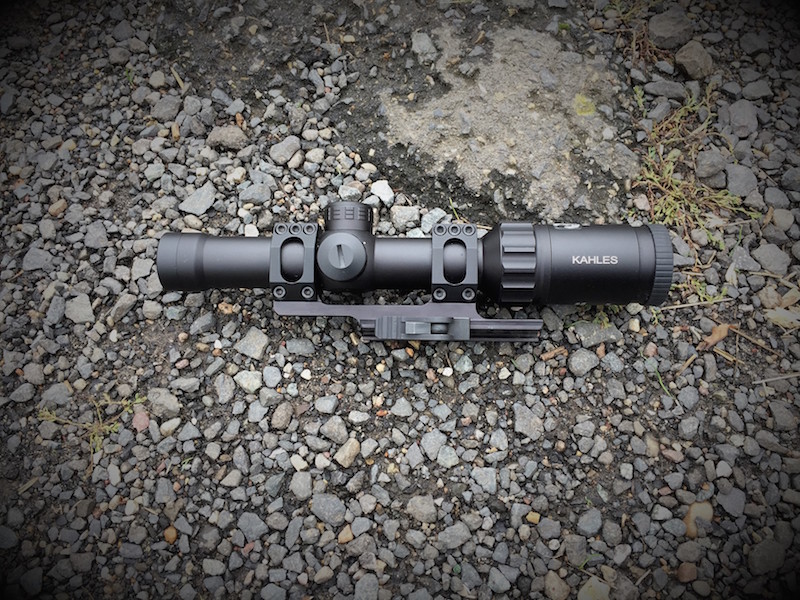 The Kahles K15i comes with a magnification that ranges from 1x to 5x. It has an objective diameter of 24mm. The glass is approximately 28cm long and has a main tube diameter of 30mm. The eye relief is a remarkable 95mm, with the diopter adjustable from +2 to -3.5 dpt. The K15i is also illuminated, as it can be used as a red dot sight at 1x. The weight of the scope is balanced at 480 grams, not too heavy but still robust and designed for tougher demands.
The Kahles K15i comes with a magnification that ranges from 1x to 5x. It has an objective diameter of 24mm. The glass is approximately 28cm long and has a main tube diameter of 30mm. The eye relief is a remarkable 95mm, with the diopter adjustable from +2 to -3.5 dpt. The K15i is also illuminated, as it can be used as a red dot sight at 1x. The weight of the scope is balanced at 480 grams, not too heavy but still robust and designed for tougher demands. 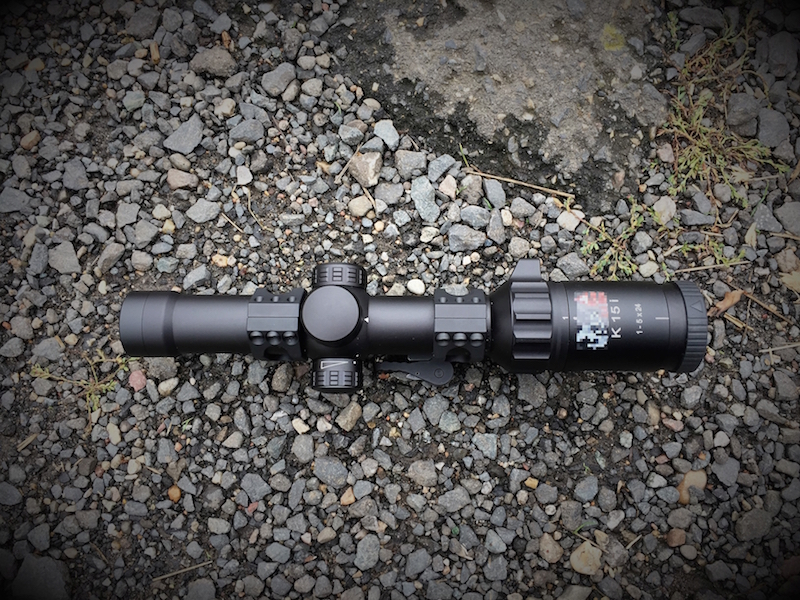 Here are the key data at a glance:
Here are the key data at a glance:
Magnification: 1-5x
Objective diameter: 24 mm
Field of view: 42.3 m 1x at 100 meters
08.0 m 5x at 100 meters
Eye relief: 95 mm
Diopter adjustment: 2/-3.5 dpt
Twilight factor: 3.1 - 11.0 DIN 58388
Point of impact adjustment per click: 0.36 inch (100yds)
10 mm
.1 MIL
Adjustment range (H/S): 2.2 / 2.2 m
Main tube diameter: 30 mm
Length: 278 mm
Weight: 480 g
Reticle in image plane: 2
illuminated: yes
Warranty: 11 years
Now that we know what we have in our hands, let's take a closer look at the scope. The first thing that stands out is the slim and minimalist design. The adjustment turrets are extremely flat and have a waterproof cover. 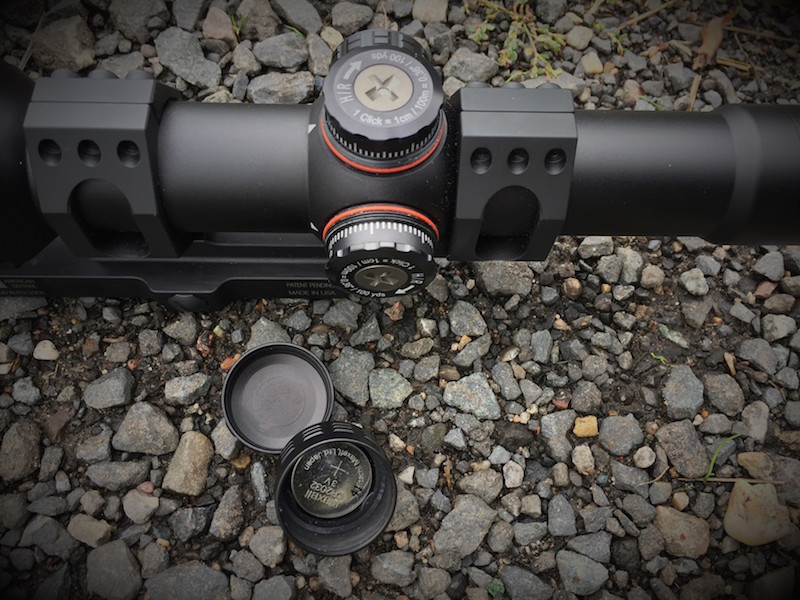 Adjustment for windage and elevation is done in 0.36 inch (at 100 yards) or 1cm at 100 meters. It can be adjusted by 2.2 meters. Usually, you zero a scope at 100 meters and have that setting as a base. To avoid having to remember, there is the so-called zero position or zero return. The glass is set, then the scale on the adjustment turret is turned to 0, by operating a mechanism to only rotate the scale and not change the setting. In the case of the Kahles K15i, the lock is released in the middle using a cartridge case, a coin, or a screwdriver, the scale is set to 0, and then the lock is re-engaged. This way, you have the 100-meter zero at 0 and can adjust as needed, for example, to 300 meters. After use, you simply turn it back to 0 and the rifle shoots precisely at 100 meters again.
Adjustment for windage and elevation is done in 0.36 inch (at 100 yards) or 1cm at 100 meters. It can be adjusted by 2.2 meters. Usually, you zero a scope at 100 meters and have that setting as a base. To avoid having to remember, there is the so-called zero position or zero return. The glass is set, then the scale on the adjustment turret is turned to 0, by operating a mechanism to only rotate the scale and not change the setting. In the case of the Kahles K15i, the lock is released in the middle using a cartridge case, a coin, or a screwdriver, the scale is set to 0, and then the lock is re-engaged. This way, you have the 100-meter zero at 0 and can adjust as needed, for example, to 300 meters. After use, you simply turn it back to 0 and the rifle shoots precisely at 100 meters again.
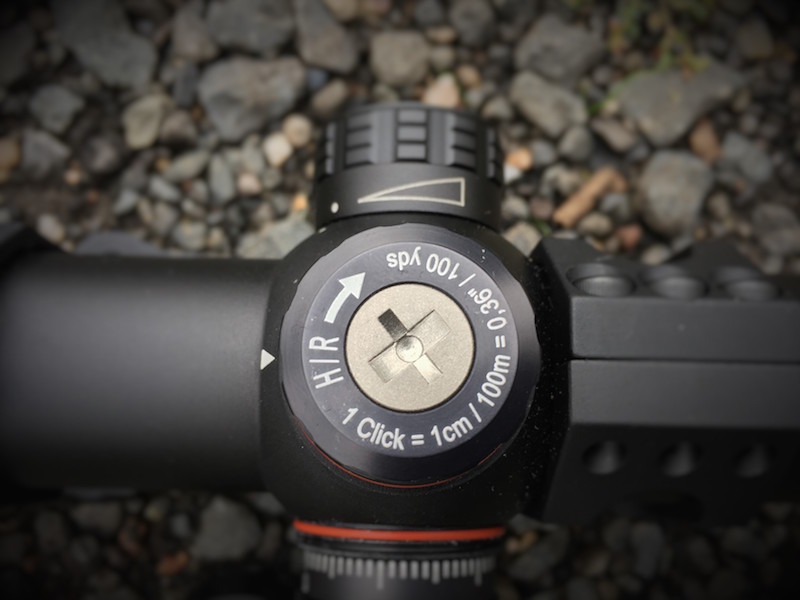 Illumination is stepless via the left turret. Although it may not look like it in the pictures, the illumination is quite bright. It can definitely be used as daylight illumination, although not as good as a "real" red dot sight. It is important to note that a scope with illumination usually has an etched reticle, which is always visible, and the illumination is only for faster target acquisition. In addition to a simple dot, an extra circle around the dot - the so-called Circle Dot - is helpful in bright daylight conditions. This is not present in the SM2 reticle shown here, but other reticles can of course be selected - more on that later. The illumination is powered by a CR2032 battery, which lasts about 34 hours on the highest brightness level and 350 hours on the lowest. A spare battery can be carried in the right turret cover.
Illumination is stepless via the left turret. Although it may not look like it in the pictures, the illumination is quite bright. It can definitely be used as daylight illumination, although not as good as a "real" red dot sight. It is important to note that a scope with illumination usually has an etched reticle, which is always visible, and the illumination is only for faster target acquisition. In addition to a simple dot, an extra circle around the dot - the so-called Circle Dot - is helpful in bright daylight conditions. This is not present in the SM2 reticle shown here, but other reticles can of course be selected - more on that later. The illumination is powered by a CR2032 battery, which lasts about 34 hours on the highest brightness level and 350 hours on the lowest. A spare battery can be carried in the right turret cover.
To adjust the magnification, there is a grippy ring available with just the right resistance. In addition to the textured ring, a fin is installed, allowing for quick adjustment - all precise and fine with the fingers, even with gloves on, or firmly gripped with the whole hand around the ring.
Before we look at the reticle and view through the glass, let's briefly focus on the ocular ring. This is used for diopter adjustment and can be adjusted from +2 to -3.5 dpt. Looking through the glass initially makes it clear: we are too close. So, keeping the correct 9.5cm eye relief and behold, a sharp image. But not just sharp - it's absolutely brilliant. As mentioned earlier, we have never come across something like this. Sharp and clear, yes, but like this? No. Add to that the slim housing edge and the high eye relief, which almost puts the glass on par with operating a red dot sight. Thanks to a huge eye box, you don't have to search, but rather get the dot burned onto the retina.
The eye box is the imaginary area in front of the ocular where you start to see the dot or reticle. Even before you have a fully clear picture, the dot is visible and you can take a shot. This feature becomes advantageous when operating from unusual or awkward shooting positions. The larger the eye box, the more precisely the head must be positioned behind the sight, which is not always possible in some shooting positions.
Normally, these points alone would be sufficient to define a top glass, but no - here comes the incredibly wide field of view of 42 meters at 1x on 100 meters and still an impressive 8 meters at 5x. 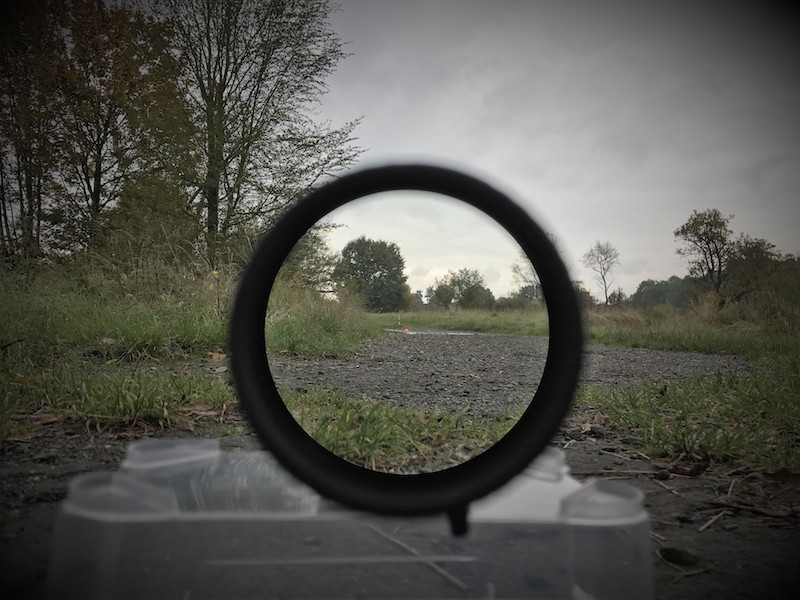 The reticle used here is called SM2. The large aiming point clearly indicates its primary use in close quarters, but the reticle can also be used at a distance. However, especially in the sporty context, it becomes clear that the point covers quite a lot of the target at 100 meters and may not be the first choice for precision work. At the highest magnification of 5x, the point covers a whole 7cm at 100 meters. Further details can be seen in the attached reticle diagram. At this point, we would like to point out the SI1 reticle, which we believe provides the ideal combination of speed and precision. With the SI1, you have a small 1.2 MOA dot (5x) for accurate shooting and a circle around it, similar to the fastest reflex sight - the Eotech - which greatly speeds up target acquisition. In addition, there are additional triangles as aiming points under the Circle Dot. All in all, an excellent reticle that we will surely take a closer look at.
The reticle used here is called SM2. The large aiming point clearly indicates its primary use in close quarters, but the reticle can also be used at a distance. However, especially in the sporty context, it becomes clear that the point covers quite a lot of the target at 100 meters and may not be the first choice for precision work. At the highest magnification of 5x, the point covers a whole 7cm at 100 meters. Further details can be seen in the attached reticle diagram. At this point, we would like to point out the SI1 reticle, which we believe provides the ideal combination of speed and precision. With the SI1, you have a small 1.2 MOA dot (5x) for accurate shooting and a circle around it, similar to the fastest reflex sight - the Eotech - which greatly speeds up target acquisition. In addition, there are additional triangles as aiming points under the Circle Dot. All in all, an excellent reticle that we will surely take a closer look at. 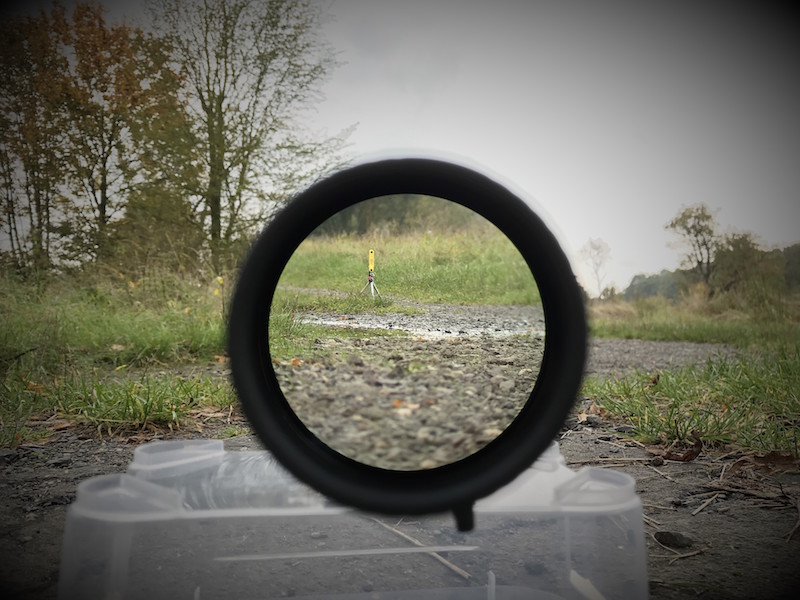 In practice, we have tested the scope for several months, which we have thoroughly done. Primarily used on an AR15, the glass performed well in close quarters, as well as at 50, 100, and 300 meters. We found the reticle slightly obstructive at 100 meters during sport shooting on BDS targets, as the dot covered quite a bit. Especially when not shooting supported, it was a real challenge, and for this application, a different reticle from the selection should definitely be considered.
In practice, we have tested the scope for several months, which we have thoroughly done. Primarily used on an AR15, the glass performed well in close quarters, as well as at 50, 100, and 300 meters. We found the reticle slightly obstructive at 100 meters during sport shooting on BDS targets, as the dot covered quite a bit. Especially when not shooting supported, it was a real challenge, and for this application, a different reticle from the selection should definitely be considered. 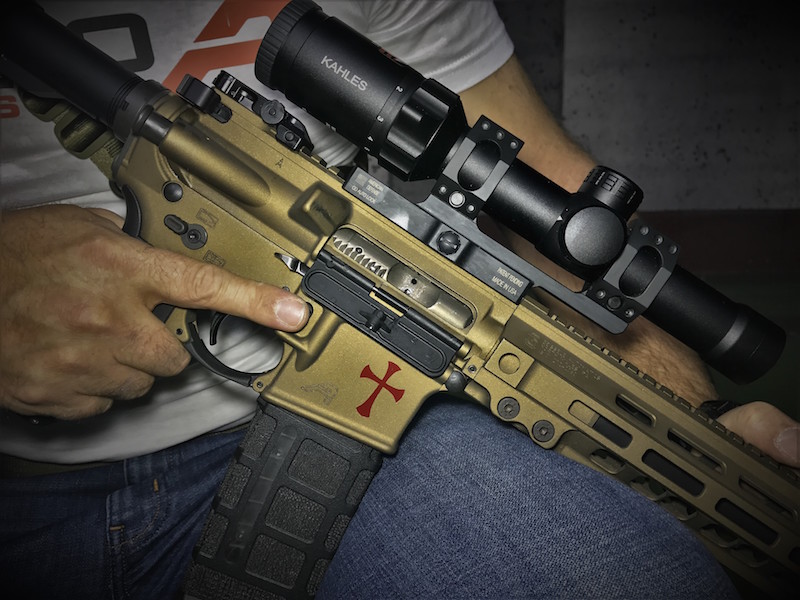 On the mostly dark shooting ranges, the optics were always bright enough and, thanks to the high edge sharpness, also usable. The stepless illumination also fit perfectly and allowed for finer adjustment than with a stepped mode.
On the mostly dark shooting ranges, the optics were always bright enough and, thanks to the high edge sharpness, also usable. The stepless illumination also fit perfectly and allowed for finer adjustment than with a stepped mode.
We tested the repeatability of the zero position when switching between distances with a shooting rest, and there were no issues.
CONCLUSION: All in all, the Kahles K15i is honestly the best and fastest low power scope we have used so far. For a semi-automatic rifle in caliber .223 or 308, we can highly recommend it, even if it's not exactly cheap. In return, you get an absolute top product that has few weaknesses and provides the shooter with an incredible field of view. We have only experienced something like this with pure red dot sights, which are ultimately the experts in this field. The illumination and battery life are the only weaknesses, but it should be noted that this is only in comparison to red dots - compared to scopes, we have never had a glass in hand that was more brightly illuminated. If you want all the data and the reticle: HERE is the datasheet for the Kahles15i.
The Kahles K15i can be found at all retailers that carry Kahles for between 1,600 and 1,900€. A proud price, but absolutely justified, we believe.
Many heartfelt thanks to Kahles for providing us with the test sample. We also thank Schießsportcentrum Heusenstamm, where we always receive warm support.
Kahles on the Internet: SPARTANAT is the online magazine for Military News, Tactical Life, Gear & Reviews.
Send us your news: [email protected]
Ad
similar
Get the weekly SPARTANAT newsletter.
Your bonus: the free E-Book from SPARTANAT.


